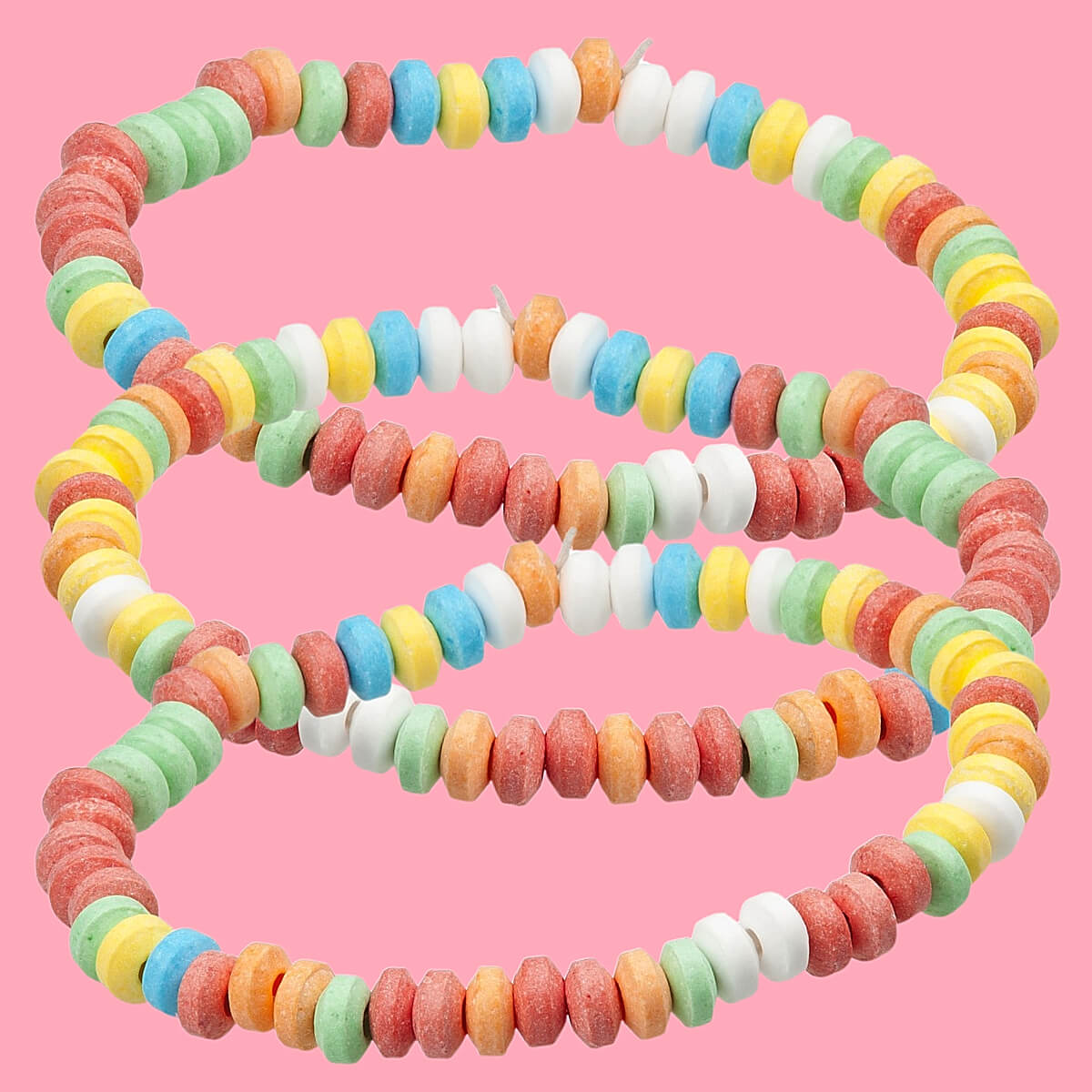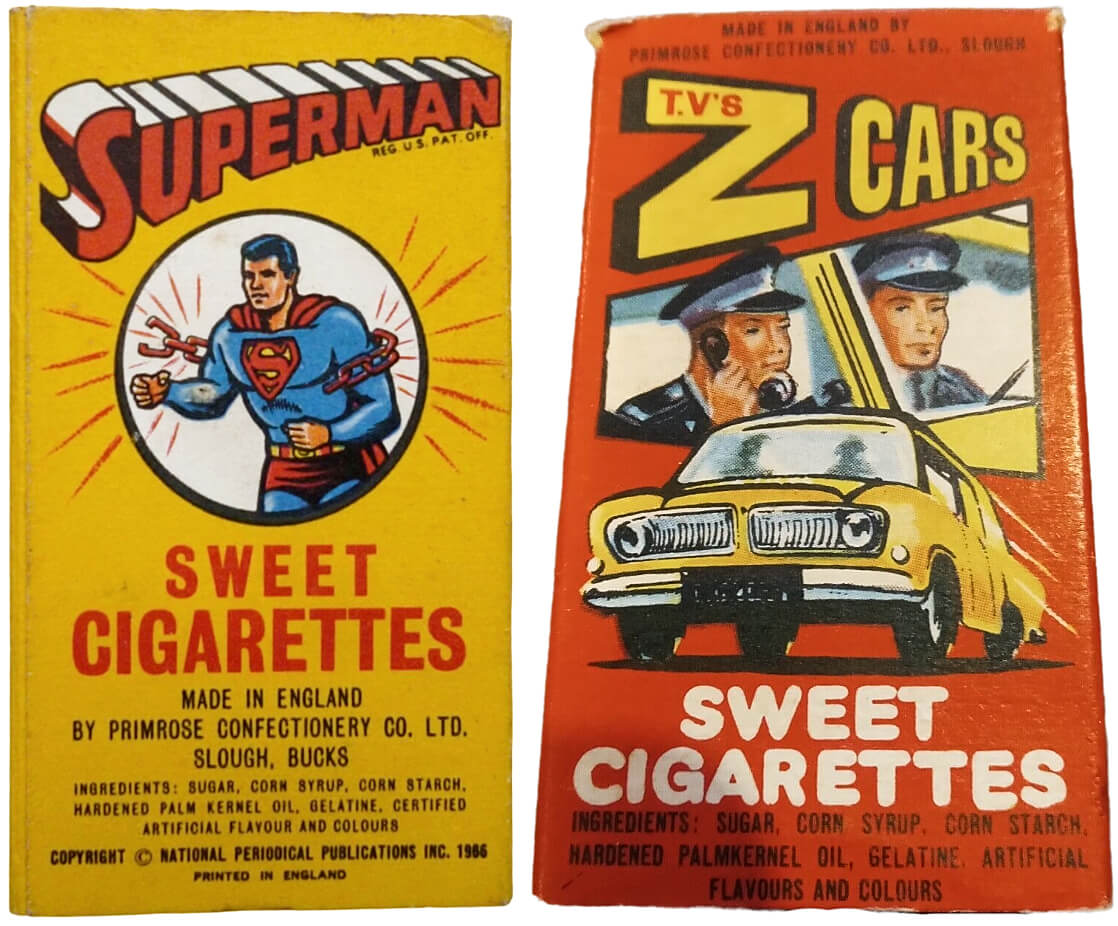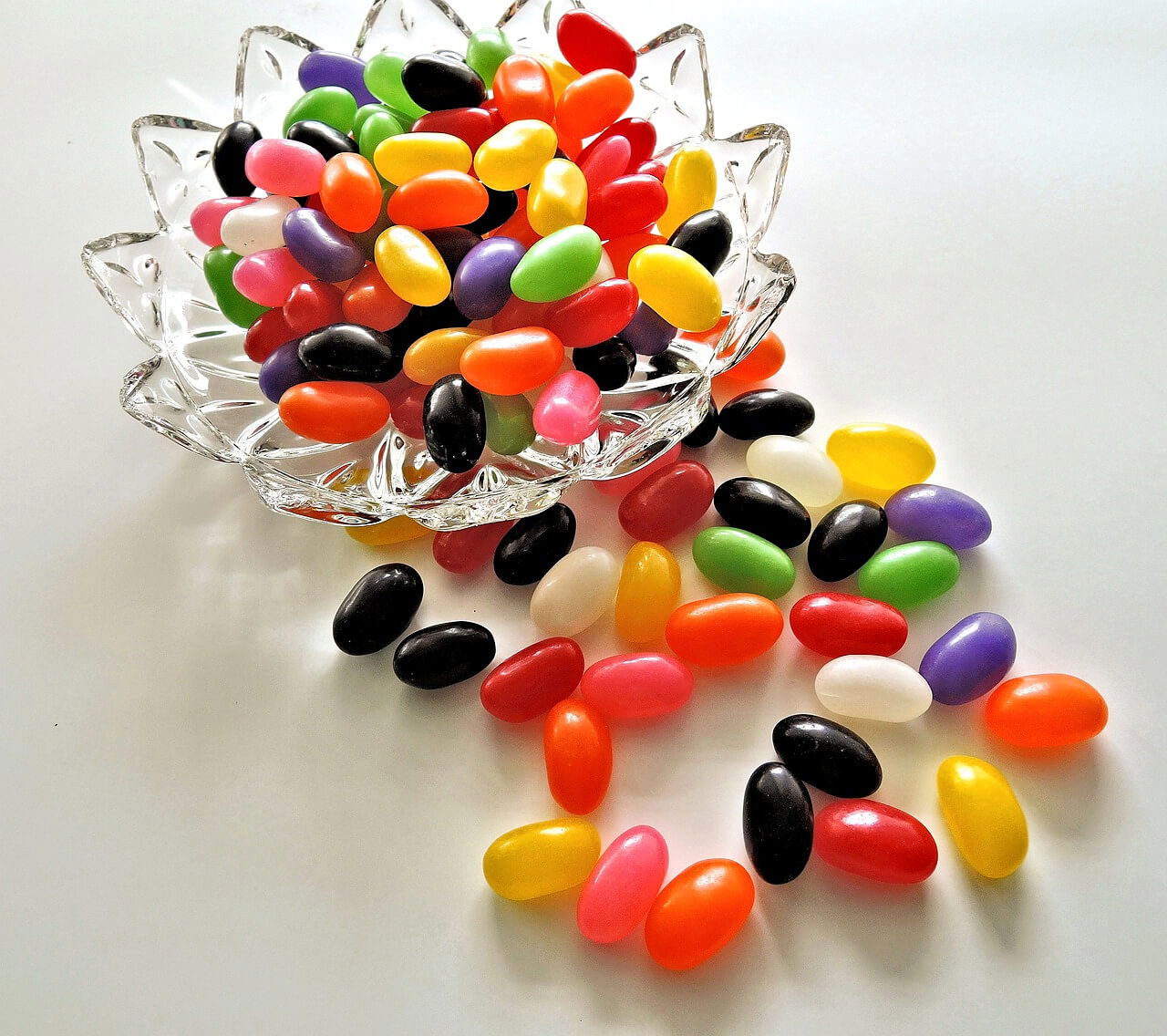60 Classic Retro Sweets You Can Still Buy Today
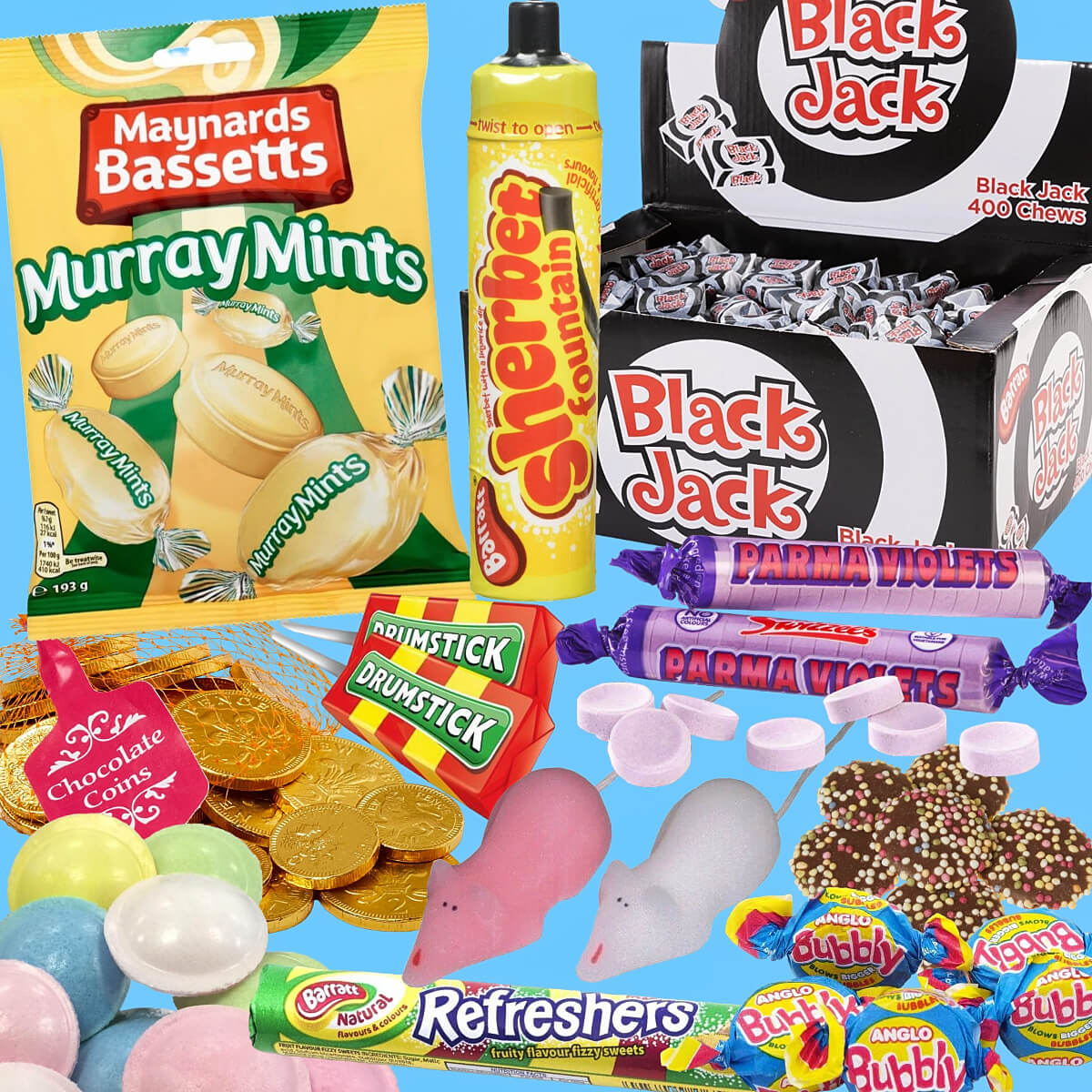
Retro sweets are hugely popular and stir up nostalgic childhood memories for many people, taking them back to simpler, carefree times. We explore all of the classic confectionary from the 19th and 20th centuries, with many from the 1960s, 70s, 80s and 90s. So, browse away and rekindle some happy memories with our comprehensive A-Z list of British retro sweets, featuring 60 classics you can still buy today.
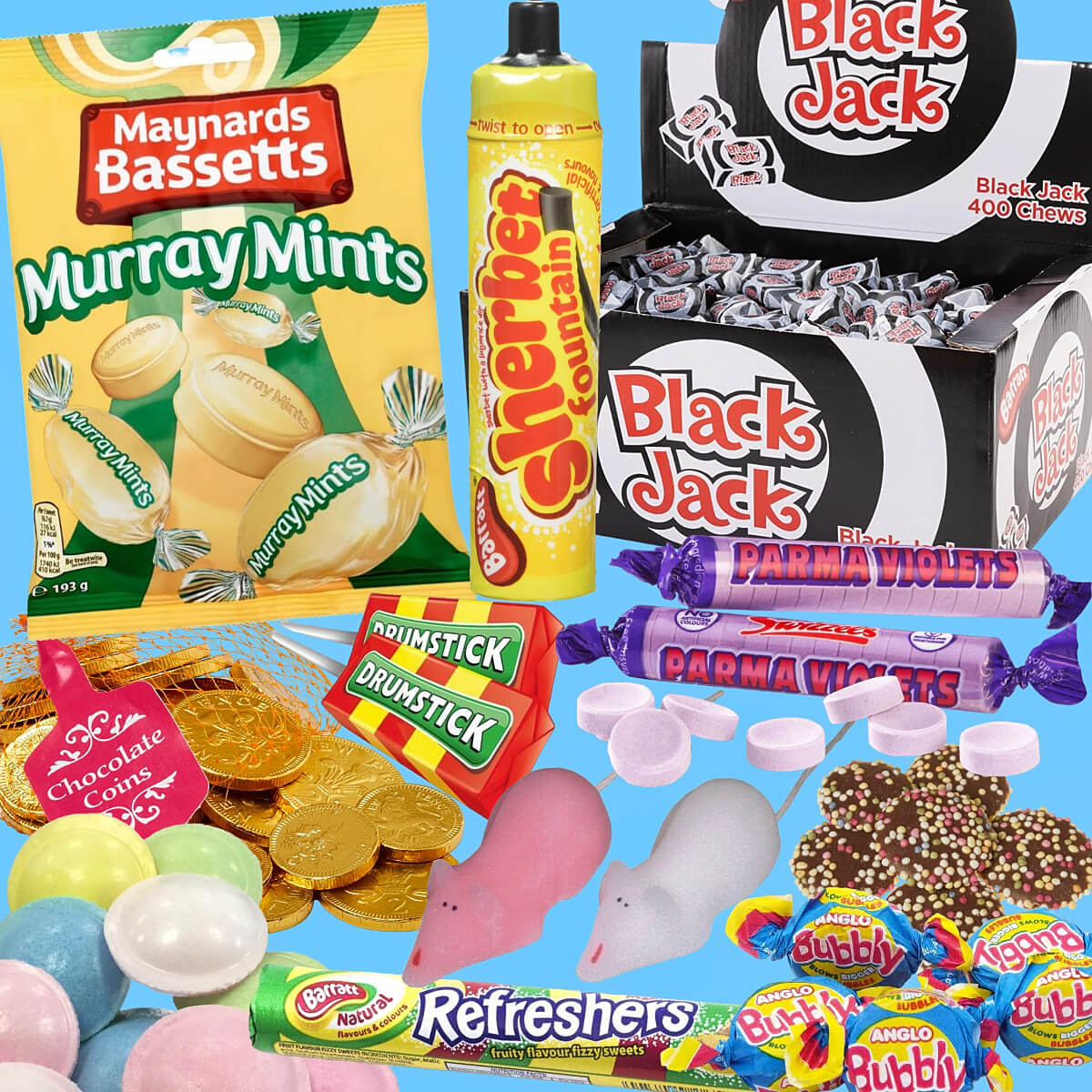
You can purchase any product below using the picture links.
Disclosure: This page contains affiliate links. As an Amazon Associate, I earn from qualifying purchases.
Acid Drops
A delightfully tangy and sour, traditional boiled sweet which makes your tongue tingle, and with a refreshing, zesty lemon taste. Acid Drops originate from the Victorian era but remain hugely popular in the 21st century.
Alphabet Sweets
One of the most fun retro sweets which bring back memories of sharing out the colourful letters with your friends in the school playground and creating your name with them. These are also know as alphabet letters and ABC candy.
Anglo Bubbly
This very British and iconic brand of pear-flavoured, pink bubble gum was launched in the 1930s by Barratt, but was particularly popular in the 1970s and 80s. It comes with the slogan "Blows bigger bubbles".
Aniseed Balls
Not everyone is a fan of aniseed, but for those who are, aniseed balls are simply heavenly! They're quite like a mini gobstopper, being long-lasting and slowly melting away in the mouth to reveal either a rapeseed or sugar crystal centre. The hard-boiled version of the Aniseed Ball containing aniseed oil was introduced in 1910.
Barley Sugar
This is a very tasty old fashioned, orange coloured hard-boiled sweet originating from 17th century France. The original recipe was created in 1638 by Elizabeth Pidoux, the first Mother Superior of the Benedictine nuns from Moret-sur-Loing. There is a Barley Sugar Museum in the town.
Black Jack Chews
A true British retro classic, these are aniseed flavoured chews that make your tongue go black! The chew was introduced in 1920 by Barratt, and the original wrappers pictured a smiling golly. However, in the late 1980s, Trebor finally decided to replace the golly logo due to its racist tones.
Candy Ice Cream Cones
These are a childhood classic and feature an irresistible combination of creamy strawberry and vanilla chocolate flavours. Best of all, they don't melt all over your hands like an ice cream!
Candy Lipstick
Edible lipstick is very popular with young girls and definitely a school playground favourite. The only version available today is Swizzels Love Hearts Lipstick but they still have that classic taste. Candy lipsticks make for great birthday party favours.
Candy Necklace (Beads)
What little girl doesn't like a colourful string of multi-coloured sweets that your can wear like a necklace and then eat? These were first available back in the 1970s, and are always a winner at kids parties.
Candy Sticks (Sweet Cigarettes)
Back in the 1960s and 70s, sweet cigarettes were sold in packets featuring superheroes such as Superman, Batman and Spider-Man, and there was even a Z-Cars version, which seems pretty outrageous now! These were eventually banned but you can still buy white candy sticks.
Candy Whistle
The classic Candy Whistle by Swizzels is a lot of fun, and has been popular with many generations of children since the 1960s. The plastic whistles make an Ideal birthday party bag filler.
Chewits
Chewits launched in 1965, and are cube-shaped, soft and chewy sweets that originally came in four fruit flavours; strawberry, blackcurrant, orange and banana. The iconic 1980s TV adverts featured a Godzilla-like creature named Chewy and proved to be extremely popular.
Chocolate Coins
A net of golden coins could always be found near or hanging from the Christmas Tree in many households across the UK in the 1970s and 80s, but by Christmas Day there were never any left - the temptation was just too much!
Chocolate Footballs
Featuring a solid ball of milk chocolate wrapped in foil that resembles a classic football, and often sold in a variety of colours, the classic milk chocolate footballs are particularly popular with young boys, and a childhood favourite from the 20th century.
Chocolate Jazzles
These are basically chocolate buttons covered with colourful sprinkles (known as hundreds and thousands), and I remember they used to have a wonderful aroma when you opened the brown paper bag. Appealing to the eye, these have been popular for many generations.
Chocolate Limes
A delicious hard-boiled lime shell which hides a sublime soft chocolate centre. This contrast of textures and tastes makes these an irrestible and heavenly treat.
Chupa Chups Lollies
The Spanish lollipop was launched in 1958 by Enric Bernat and became very popular in the UK, too. The name plays on the verb chupar which means "to suck". There was always a display of these on the counter of our local newsagent back in the day.
Coconut Mushrooms
Shaped like a real mushroom, Coconut Mushrooms are succulent retro sweets feature a white fondant stalk with a brown mushroom head dusted in desiccated coconut, and were first introduced in the early 1960s.
Dip Dab
The classic fizzy lemon sherbert powder that comes with a free strawberry lolly for dipping, conjurs up happy memories of a simpler 70s childhood, which was the decade in which it was launched by Barratt.
Dolly Mixture
A firm favourite since the 1920s, Dolly Mixtures are a combination of tiny fondant candy pieces, japs and jelly tots in mixed colours. It looks like a miniature version of liquorice allsorts and is the perfect alternative for those who don't like liquorice.
Double Lollies
Launching in 1952, Swizzels Double Lollies are a retro favourite that feature two different flavours and colours on a single stick. They used to be sold loose and unwrapped, but the modern version is wrapped for hygeine reasons, although they have definitely shrunk in size since I was eating them in the 1970s.
Drumstick Lollies
Introduced in 1957, these classic Raspberry and milk flavour Drumstick chewy lollies are made by Swizzels Matlow and each lolly features the a wrapper with the iconic green, red and yellow colours.
Everton Mints
The Everton Mint stands as a classic British confection featuring a toffee centre, and is renowned for its unmistakable black and white stripes. They originate from a sweet shop in Liverpool near Goodison Park, the iconic home of Everton FC but are now widely available, thankfully!
Fizzers
These fizzy and fruity retro sweets by Swizzels Matlow have a hard but brittle feel to them and leave a wonderful tingling sensation on the tongue. Fizzers were Swizzels very first product and launched in 1933. Containing six fruit flavours, they are similar to Barratt's Refreshers, but the small-sized rolls are ideal party bag fillers.
Fizzy Cola Bottles
With its distinctive fizzy, sour cola taste, this is a classic jelly sweet that was invented in the 1930s in Germany but is often associated with 1970s Britain. The fizzy cola bottle became an iconic penny sweet in the UK during the 70s.
Fizzy Bubblegum Bottles
These delightful pink and blue mini bottle-shaped sweets taste just like bubblegum, and are dipped in a fizzy sherbet sugar coating. Bubblegum itself was invented by an American accountant named Walter Diemer, in 1928.
Flying Saucers
Flying Saucers originate from the 1950s and are truly iconic. They contain sherbert in the middle encased by a melt-in-your-mouth outer shell made from coloured rice paper. They are called UFOs in Belgium, the country in which they were invented.
Fried Eggs
Fried egg sweets gummies look just like a fried egg but, thankfully, taste fruity, and not of real egg. They were introduced by the German company Haribo in the 1950s and quickly became an iconic favourite sweet in the UK.
Fox's Glacier Mints
The clear and smooth boiled peppermint sweets originate from 1928, and there was a series of cartoon adverts in the 1970s and 80s featuring Peppy the polar bear and Eric the fox. Fox's Glacier Mints are flavoured with natural peppermint and last for a satisfyingly long time in your mouth.
Fruit Jellies
These were particularly popular in the 1960s and 70s, and my nan always used to hand these out around Chrisymas time. They're an acquired taste and texture but are a true retro classic, and it's great to see that they are still available.
Fruit Salad Sweets
The iconic pink and yellow penny chew has an unmistakable raspberry and pineapple flavour. They were introduced by Barratt in 1920, alongside the Black Jack. They're no longer a penny sweet, of course, but still every bit as enjoyable.
Jelly Babies
These fruity classics were introduced by Bassett in 1918 but were originally called Peace Babies. After production halted in the World War II, they were relaunched as Jelly Babies in 1953. Whovians will know that the fourth Doctor's catchphrase was "Would you like a jelly baby?" and may even remember Tom Baker offering one to Davros!
Jelly Beans
These vintage sweets are gorgeously fruity and chewy, and bursting with flavour. They date back to the late 19th century, and were invented in 1861 by Boston (USA) confectioner William Schrafft.
Jelly Spogs
Originally named Jelly Buttons, these classic British jelly sweets are flavoured with aniseed and coated in crunchy pink and blue balls. They are also included in Liquorice Allsorts.
Kola (Cola) Cubes
Almost self-explanatory, these are delighful, cube-shaped boiled sweets dusted with icing sugar and with a decent cola flavour and in an unmistakable red colour. They were invented in the 1940s by the Pascall confectionary company but were originally chewy.
Liquorice Allsorts
When Barrett's salesman, Charlie Thompson, dropped a tray of sweet samples on the floor in 1899, he unintentionally created a vibrant mix of colours and flavours which became Liquorice Allsorts. Everyone has a favourite. I don't like the pink and blue jelly spogs but will devour the rest of them!
Liquorice Wheels
Many people have fond memories of unravelling a wheel of liquorice and then breaking off pieces to share with friends at school - you can just eat the whole thing yourself, of course! Liquorice Catherine Wheels have a blue, pink Jelly Spog in the centre (sometimes orange is also included) although they're not as widely available today.
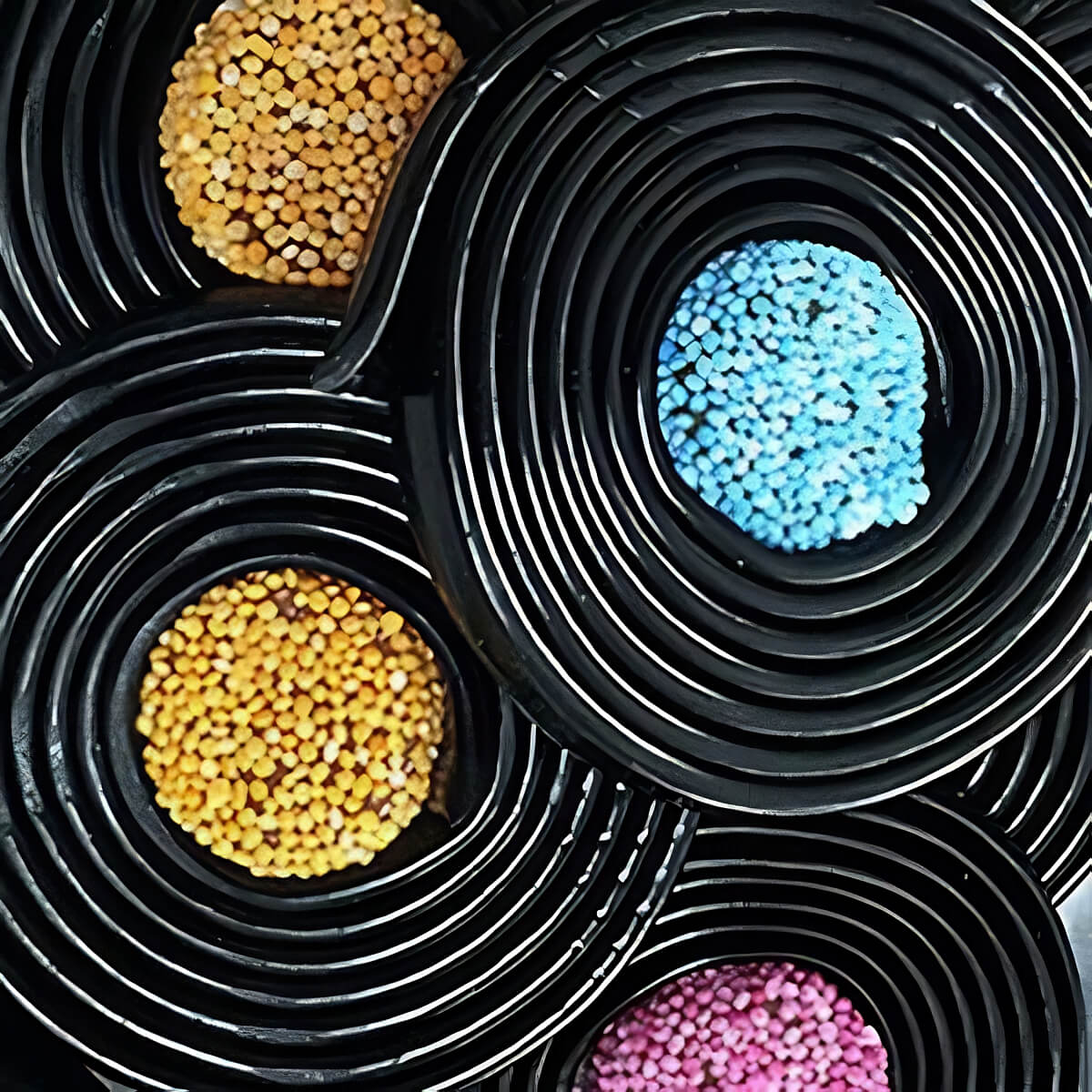
Liquorice Pipes
As with sweet cigarettes, these give rise to controversy but are, surprisngly still available to buy and look exactly the same as they always have, with the end being decorated with pink sprinkles to represent burning tobacco.
Liquorice Torpedoes/Comfits
These colourful retro sweets feature a crispy sugar coating with a gorgeously chewy liquorice centre. We used to call them torpedoes, although this may have just been a local thing!
Love Hearts
These traditional mini sweets feature sentiments printed within a 'love heart'. Back at school in the 1970s, the girls used to hand these out to a boy they fancied in the hope that they might get the message! These also make great wedding favours. Read more about Love Hearts
Milk Bottles
The deliciously creamy milk bottle shaped chewy sweets are also known as milk gums. They were very popular when I was a child in the 1970s, and are now classed as retro sweets. They hark back to a time when almost everyone had their milk delivered in bottles by the local milkman. Read more about Milk Bottles
Milk Teeth
As they look like false gnashers, these certainly have the novelty factor and are still loved by young children today. Milk Teeth are sugar dusted, pink and white sweets with a scrumptious strawberry and vanilla flavour.
Murray Mints
Murray Mints are a classic boiled caramel sweet that was introduced in 1944, and named after Robert Murray. In the 1950s, they came with the slogan "Too good to hurry mints". Today they are made by Maynards Bassetts but taste as delicious as ever.
Parma Violets
The perfumed flavour of Parma Violets is certainly an acquired taste but the iconic violet-flavoured, disc-shaped sweets by Swizzels Matlow have a decicated fan base, and have been discovered by new generations of sweet lovers since their introduction in 1946.
Peanut Brittle
Delcious roasted peanuts embedded in caramelised sugar. The sweet and salty taste is devilishly addictive but my aging teeth can no longer handle it, sadly. Peanut Brittle is believed to originate from South America in the late 19th century, and is defintely not a British invention.
Pear Drops
This is a traditional red and yellow boiled sweet shaped like a pear and with a distinctive pear flavour. Very delicious and some varieties have separate red and yellow colours, while others combine the two colours into one sweet (in two halves). Pear Drops have their roots in 19th-century England, with their creation attributed to Edward Sharp, a confectioner based in the city of York.
Rainbow Drops
Originating from the 1930s and made from puffed rice coated in sugar, Swizzels Rainbow Drops were originally sold loose. The colourful retro classic is now conveniently avialable in share bags and as popular as ever!
Refreshers by Barratt
Introduced by Barratts in 1935, virtually everyone remembers these pastel-coloured, fizzy sweets, which are a true retro classic. They're an acquired taste, though, and I have to admit that I really can't stand them! But you either love them or hate them, I guess!
Refreshers by Swizzels
Invented in 1963, Swizzels Refreshers are not related to the Barratt Refreshers above and have the original lemon taste and taste just the as they always have. These are also available in strawberry and sour apple flavours.
Rhubarb & Custard
A very British, traditional boiled sweet that tastes like the classic pudding. There are many modern versions of the sweet (such as Haribo's version) which are very different but can't match the original version. We recommend Maxons if you want an authentic taste from your childhood.
Rowntree's Fruit Pastilles
It's almost impossible not to chew the fruity jelly sweet with its crispy sugar coating, which was introduced in 1881. Rowntree's Fruit Pastilles are still made in England, despite being owned by Swiss giant Nestlé since 1988.
Sherbert Fountain
The Sherbert Fountain is a nostalgic delight that was invented by Henry Edward Brunt, and then introduced by Barratt in 1925. The original tubes were made from card, with the end of the liqourice dipping stick poking out of the top, giving it the appearance of a firework or bomb. They are now plastic with a sealed cap but still filled with glorious sherbet and liquorice stick.
Spearmint Chews
Back in the 1970s we had Pacers (remember them?) but spearmint chews were also popular in the local sweet shop. They're chewy and taste of spearmint - what's not to like!
Sugar Mice
In Britain, sugar mice have adorned Christmas celebrations since the Victorian era, becoming a cherished tradition. Victorian children would frequently craft these sweet treats as heartfelt gifts for their parents, adorning the Christmas tree with these delightful creations.
Sugared Almonds
Sugared Almonds often used as wedding favours due to their pastel coloured, crisp, candy shell. The contrasting bitterness of the almond and sweetness of the shell combine to give an irresistible taste sensation. Some confectioners offer a one colour coating which can even include gold or silver.
Super Shrimps (Foam Shrimps)
These classic, foamy, raspberry mallows have been around for many generations and were launched by the British confectionary company Barratt back in the 1940s. Super Shrimps are a timless classic still enjoyed by a new generation of youngsters.
Sweet Bananas (Foam Bananas)
A soft and juicy, melt-in-the-mouth chew that features a lovely mellow banana flavour. These are often sold mixed with foam shrimps
Sweet Peanuts
Shaped like monkey nuts (peanuts in their shells), these are delightful retro sweets with a smooth and buttery caramel taste. However, they do not actually contain any peanuts but do have a slightly nutty flavour.
Traffic Light Lollipops
These lollies are a 20th century classic and they are particularly popular because the yummy flavour changes as you suck through the three different colours.
White Chocolate Snowies/Jazzles/Jazzies
These are the sweeter, white chocolate version of brown jazzles, and it is common for people to mix the two together at parties. The deliciously creamy chocolate is sprinkled with crunchy candy to give a very satisfying experience.
I hope you enjoyed reading our list of 60 classic retro sweets you can still buy today, and that we have made you feel all nostalgic.
You may also like The Sweet History of Rowntree's
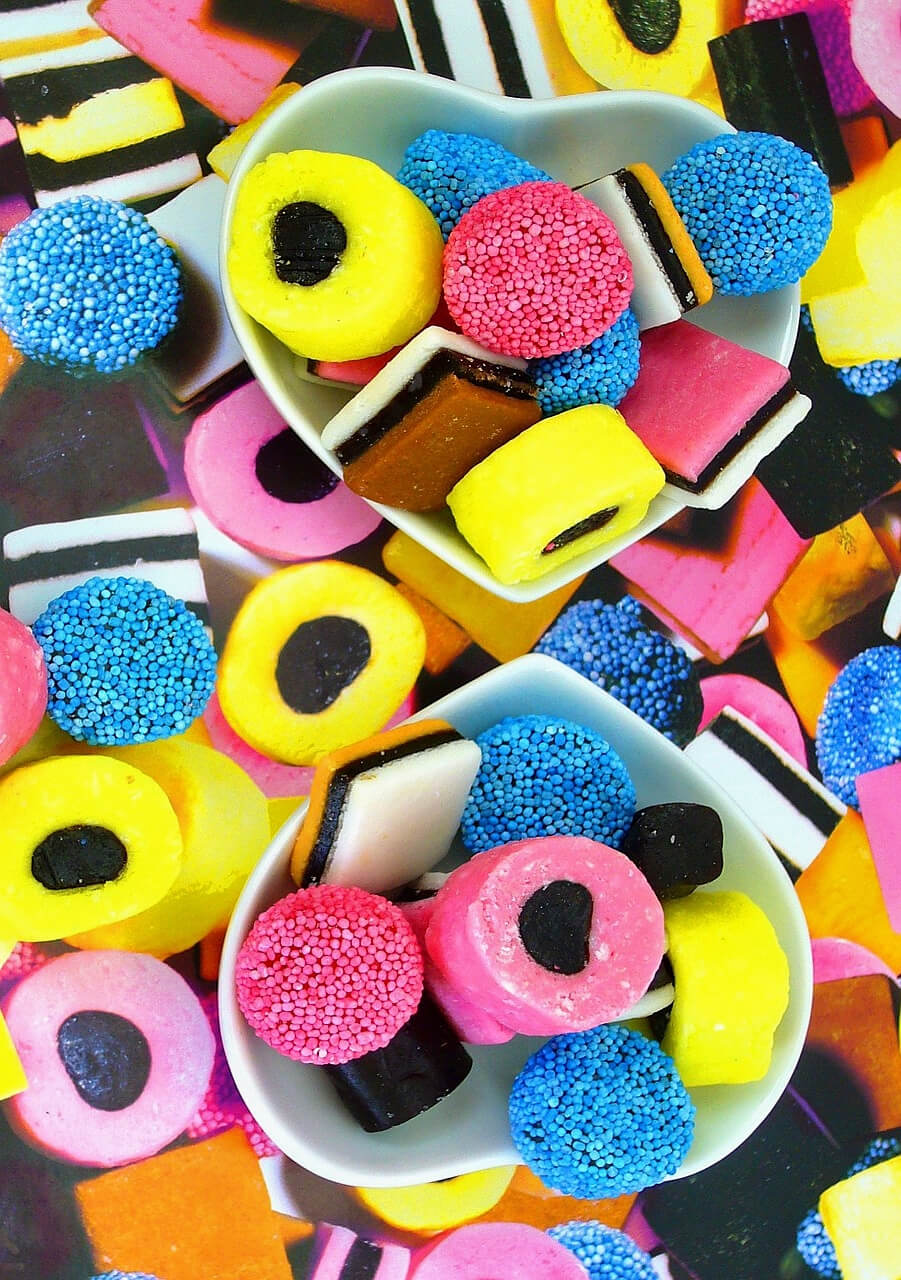
Liquorice Allsorts, a retro classic.
